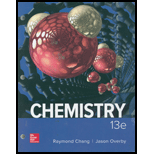
The dissociation of molecular iodine into iodine atoms is represented as
At 1000 K, the equilibrium constant Kc for the reaction is 3.80 × 10−5. Suppose you start with 0.0456 mole of I2 in a 2.30-L flask at 1000 K. What are the concentrations of the gases at equilibrium?
Interpretation:
The equilibrium concentration of hydrogen and iodine gas has to be calculated.
Concept Introduction:
Equilibrium concentration: If Kc and the initial concentration for a reaction and calculate for both equilibrium concentration, and using the (ICE) chart and equilibrium constant and derived changes in respective reactants and products.
Equilibrium constant: Concentration of the products to the respective molar concentration of reactants it is called equilibrium constant. If the K value is less than one the reaction will move to the left side and the K values is higher (or) greater than one the reaction will move to the right side of reaction.
Heterogeneous equilibrium: This equilibrium reaction does not depend on the amounts of pure solid and liquid present, in other words heterogeneous equilibrium, substances are in different phases.
Kp and Kc: This equilibrium constants of gaseous mixtures, these difference between the two constants is that Kc is defined by molar concentrations, whereas Kp is defined by the partial pressures of the gasses inside a closed system.
Vaporized equilibrium: This conversion of liquid in gaseous phase is known as vaporization process. At starting the rate of condensation is less than the rate of evaporation but as evaporation continues the concentration of gaseous molecule in the vapour phase increase.
Answer to Problem 14.44QP
Explanation of Solution
To find: The each reactant product equilibrium concentration should be identified given the gas phase reaction.
Write and Analyze the given gas phase chemical equilibrium reaction.
The given equilibrium reaction has a homogenous process, then the equilibrium constant can also be represented by Kp, were the Kp represents partial pressure. Then the product molecule partial pressure  is derived in step-2.
is derived in step-2.
To find: Calculate equilibrium concentration (Kp) values for given the statement of equilibrium reaction.
Calculate and analyze the (Kp) values at
We derived here (Kp) values of (I2) dissociation reaction
First we derived the initial concentration of (I2) is
We consider the equilibrium expression in terms of the equilibrium concentration.
The obtained second (x) values are negative concentration, this physically impossible so we omitted this values. First (x) value is correct one.
The given iodine dissociation equilibrium reaction the respective reactant to give the two moles of products in the gas phase and this equilibrium reaction expression contains single conditions like gases phase, the equilibrium constant can also be represented by Kp, were the “P” partial pressure. The each molar concentration values are Kp derived given the gas phase reaction at
The molar concentration (M) values are derived given the iodine
Want to see more full solutions like this?
Chapter 14 Solutions
CHEMISTRY (LOOSELEAF) >CUSTOM<
- What is the final product when hexanedioic acid reacts with 1º PCl5 and 2º NH3.arrow_forwardWhat is the final product when D-galactose reacts with hydroxylamine?arrow_forwardIndicate the formula of the product obtained by reacting methyl 5-chloro-5-oxopentanoate with 1 mole of 4-penten-1-ylmagnesium bromide.arrow_forward
- The temperature on a sample of pure X held at 1.25 atm and -54. °C is increased until the sample boils. The temperature is then held constant and the pressure is decreased by 0.42 atm. On the phase diagram below draw a path that shows this set of changes. pressure (atm) 2 0 0 200 400 temperature (K) Xarrow_forwardQUESTION: Answer Question 5: 'Calculating standard error of regression' STEP 1 by filling in all the empty green boxes *The values are all provided in the photo attached*arrow_forwardpressure (atm) 3 The pressure on a sample of pure X held at 47. °C and 0.88 atm is increased until the sample condenses. The pressure is then held constant and the temperature is decreased by 82. °C. On the phase diagram below draw a path that shows this set of changes. 0 0 200 temperature (K) 400 аarrow_forward
 Chemistry: The Molecular ScienceChemistryISBN:9781285199047Author:John W. Moore, Conrad L. StanitskiPublisher:Cengage Learning
Chemistry: The Molecular ScienceChemistryISBN:9781285199047Author:John W. Moore, Conrad L. StanitskiPublisher:Cengage Learning Chemistry: Principles and PracticeChemistryISBN:9780534420123Author:Daniel L. Reger, Scott R. Goode, David W. Ball, Edward MercerPublisher:Cengage Learning
Chemistry: Principles and PracticeChemistryISBN:9780534420123Author:Daniel L. Reger, Scott R. Goode, David W. Ball, Edward MercerPublisher:Cengage Learning ChemistryChemistryISBN:9781305957404Author:Steven S. Zumdahl, Susan A. Zumdahl, Donald J. DeCostePublisher:Cengage Learning
ChemistryChemistryISBN:9781305957404Author:Steven S. Zumdahl, Susan A. Zumdahl, Donald J. DeCostePublisher:Cengage Learning Chemistry: An Atoms First ApproachChemistryISBN:9781305079243Author:Steven S. Zumdahl, Susan A. ZumdahlPublisher:Cengage Learning
Chemistry: An Atoms First ApproachChemistryISBN:9781305079243Author:Steven S. Zumdahl, Susan A. ZumdahlPublisher:Cengage Learning
 Chemistry for Engineering StudentsChemistryISBN:9781337398909Author:Lawrence S. Brown, Tom HolmePublisher:Cengage Learning
Chemistry for Engineering StudentsChemistryISBN:9781337398909Author:Lawrence S. Brown, Tom HolmePublisher:Cengage Learning





